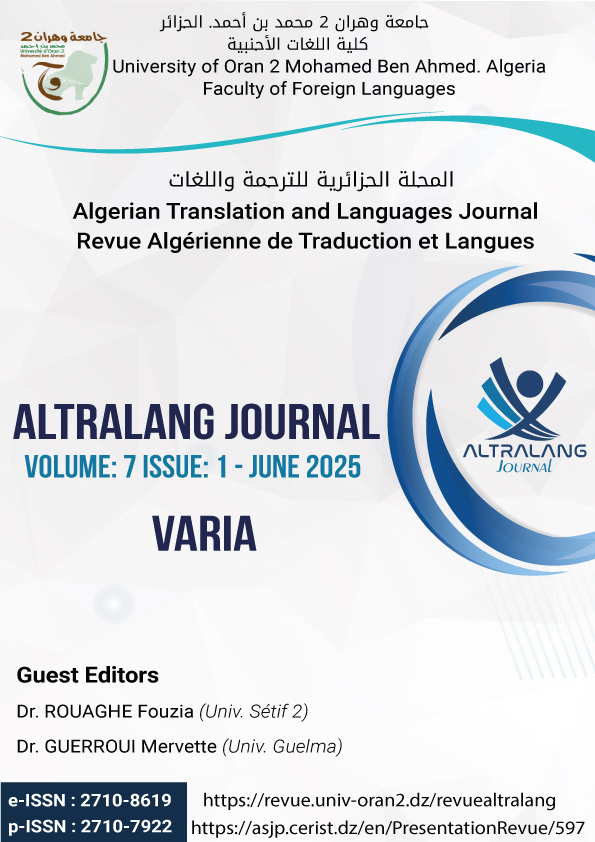The Manifestation of Trauma in Nayomi Munaweera’s What Lies Between Us: A Thematic Analysis
Main Article Content
Abstract
Trauma literature has garnered a lot of interest and has gained a significant position in today’s literary studies as it offers an outlook on the different reactions of individuals in face of disruptive experiences. Since the language of literature has a fascinating power to display the inner world of man, there has been a rising interest in trying to depict the struggles of unearthing deeply buried emotional turmoil. This gave birth to the merger of literature and psychoanalysis resulting in the emergence of literary trauma theory. The objective of the present paper is to examine how authors explore the theme of trauma in their writings to expose the struggles imposed by different kinds of traumatic experiences as their stories have been revolving around characters whose identities are lost in-between worlds and whose voices are unheard or muted. The analysis is conducted through a thematic analysis of Nayomi Munaweera’s What Lies Between Us to explore how the author employs literary devices to represent the protagonist’s experience of psychological trauma and displacement. The findings reveal the main features of Munaweera’s trauma narrative and how they are consistent with the broader framework of literary trauma theory. By analysing Munaweera’s novel, this paper provides insights into the ways literature can offer a pathway towards reconciliation and self-healing to those who have experienced trauma.
Article Details

This work is licensed under a Creative Commons Attribution 4.0 International License.
LICENSE: This work is licensed under a Creative Commons CC BY 4.0 license
References
• Al Khabbas, A. K. (2020). Permanent Trauma: A Reading of Dima Wannous’ The Frightened Ones and Ibtisam Teresa’s Cities of Pigeons. State University of New York at Binghamton.
• Anderson, S. W. (2012). Readings of Ttrauma, Madness and the Body (1st ed). Palgrave Macmillan.
• Arizti, B. (2018). “Welcome to Contemporary Trauma Culture”: Foreshadowing, Sideshadowing and Trauma in Ian McEwan’s Saturday. In Trauma in Contemporary Literature Narrative and Representation (First issued in paperback 2018, pp. 237–249). Routledge, Taylor & Francis Group.
• Balaev, M. (Ed.). (2014). Contemporary Approaches in Literary Trauma Theory. Palgrave Macmillan UK. https://doi.org/10.1057/9781137365941
• Caruth, C. (1995). Trauma: Explorations in Memory (pp. ix, 277). Johns Hopkins University Press.
• Caruth, C. (1996). Unclaimed Experience: Trauma, Narrative, and History. Johns Hopkins University Press.
• Craps, S. (2014). Beyond Eurocentrism: Trauma Theory in the Global Age. In G. Buelens, S. Durrant, & R. Eaglestone (Eds.), The future of trauma theory: Contemporary literary and cultural criticism (pp. 45–61). Routledge.
• Craps, S. (2015). Postcolonial Witnessing: Trauma out of bounds. Palgrave Macmillian.
• Croisy, S. (2012). Other Cultures of Trauma: Meta-metropolitan Narratives and Identities. AV Akademikerverlag.
• Eck, D. (1998). Gangā: The Goddess Ganges in Hindu Sacred Geography. In J. S. Hawley (Ed.), Devī: Goddesses of India (First Indian edition, pp. 137–153). Motilal Banarsidass Publishers Private Limited.
• Felman, S., & Laub, D. (2013). Testimony: Crises of Witnessing in Literature, Psychoanalysis and History. Routledge.
• Ganteau, J.-M., & Onega, S. (2014). Contemporary Trauma Narratives: Liminality and the Ethics of Form. Routledge.
• Granofsky, R. (1995). The Trauma Novel: Contemporary Symbolic Depictions of Collective Disaster. P. Lang.
• Khan, S. A., & Khan, M. U. (2021). Narrating the Indescribable: Psycho-Traumatic Persona of “the Woman” in Rahimi’s “The Patience Stone.” Liberal Arts and Social Sciences International Journal (LASSIJ), 5(1), 401–412. https://doi.org/10.47264/idea.lassij/5.1.26
• Luckhurst, R. (2008). The Trauma Question. Routledge.
• Monaco, A. (2016). Malinconia e Nostalgia Nell’opera di Jhumpa Lahiri “Melanchony and Nostalgia in the Works of Jhumpa Lahiri. Vulnerability and Resilioence” [Ph.D., Universita Di Pisa]. https://etd.adm.unipi.it/theses/available/etd-06122017-153831/unrestricted/Tesi_Lahiri_Monaco.pdf
• Mulvany, M. (2012). Robert F. Garratt, Trauma and History in the Irish Novel: The Return of the Dead. Basingstoke: Palgrave, 2011. 170 pages. GBP 50.00. Irish University Review, 42(1), 208–212. https://doi.org/10.3366/iur.2012.0026
• Munaweera, N. (with Internet Archive). (2016). What Lies Between Us. New York, NY : St. Martin’s Press. http://archive.org/details/whatliesbetweenu0000muna
• Richter, D. H. (Ed.). (2018). Companion to Literary Theory (First edition). Wiley.
• Saranya, P. (2021). From Victim to Martyr: A Feministic Study of Nayomi Munaeera’s Island of a Thousand Mirrors. New Literaria, 2(1), 105–112. https://doi.org/10.48189/nl.2021.v02i1.011
• Vickroy, L. (with Internet Archive). (2002). Trauma and Survival in Contemporary Fiction. Charlottesville : University of Virginia Press. http://archive.org/details/traumasurvivalin0000vick_m0q8
• Whitehead, A. (2004). Trauma Fiction. Edinburgh Univ. Press.
• Ziadi, A. (2016, August 6). Inheritance of Loss: A Tragic Chain of Circumstances Leads to a Young Mother’s Ultimate Failure [E-paper editorial]. The Hindu. https://www.thehindu.com/books/literary-review/Inheritance-of-loss/article14553179.ece
• Žindžiuvien, I. (2013). Elements of Trauma Fiction in the 9/11 Novel. Editura Universităţii de Vest Din Timişoara / Diacritic Timisoara, 71–81.

1.png)